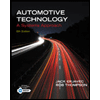
Automotive Technology: A Systems Approach (MindTap Course List)
6th Edition
ISBN: 9781133612315
Author: Jack Erjavec, Rob Thompson
Publisher: Cengage Learning
expand_more
expand_more
format_list_bulleted
Concept explainers
Textbook Question
Chapter 38, Problem 8RQ
Which of the following gear ratios indicates an over-drive condition?
a. 2.15:1
b. 1:1
c. 0.85:1
d. None of the above
Expert Solution & Answer
Trending nowThis is a popular solution!

Students have asked these similar questions
What is the gear ratio?
When discussing the various gear positions of a transfer case, Technician A says that when the transfer case is in low, the overall gear ratio is numerically increased. Technician B says that when the transfer case is in the high position, the vehicle operates in an overdrive mode due to the decrease in torque multiplication. Who is correct?
Which of the following gear ratios provides the highesttorque multiplication?a. 0.85 : 1b. 2.67 : 1c. 5.23 : 1d. 0.50 : 1
Chapter 38 Solutions
Automotive Technology: A Systems Approach (MindTap Course List)
Ch. 38 - What determines whether a conventional...Ch. 38 - Name the three drive configurations that a gearset...Ch. 38 - True or False? A reverse idler gear changes the...Ch. 38 - Define the purpose of the final drive gears.Ch. 38 - Explain the role of shift rails and shift forks in...Ch. 38 - True or False? In most transmissions and...Ch. 38 - The number of gear teeth per unit of measurement...Ch. 38 - Which of the following gear ratios indicates an...Ch. 38 - Which type of gear develops gear whine at high...Ch. 38 - When an idler gear is placed between the driving...
Ch. 38 - The component used to ensure that the mainshaft...Ch. 38 - In a transaxle, the pinion gear on the pinion...Ch. 38 - True or False? The cone on a synchronizers...Ch. 38 - Which of the following gear ratios provides the...Ch. 38 - What does a shift blocking system do, and how does...Ch. 38 - Technician A says that most transaxles have a...Ch. 38 - While discussing the various types of...Ch. 38 - Technician A says that the countergear or cluster...Ch. 38 - Technician A says that reverse lamp switches are...Ch. 38 - Technician A says that if a single idler gear is...Ch. 38 - Technician A says that in a conventional...Ch. 38 - While discussing the power flow through a...Ch. 38 - Prob. 8ASRQCh. 38 - Prob. 9ASRQCh. 38 - While discussing shift mechanisms: Technician A...
Knowledge Booster
Learn more about
Need a deep-dive on the concept behind this application? Look no further. Learn more about this topic, mechanical-engineering and related others by exploring similar questions and additional content below.Similar questions
- Technician A says that when a car is moving straight ahead, all differential gears rotate as a unit. Technician B says that when a car is turning a corner, the inside differential side gear rotates slowly on the pinion, causing the outside side gear to rotate faster. Who is correct? a. Technician A only b. Technician B only c. Both A and B d. Neither A nor Barrow_forwardThree factors to consider before deciding to apply a transmission of gear drivesarrow_forwardName the three drive configurations that a gearsetcan transfer torque.arrow_forward
- Calculate the Gear Ratio.arrow_forwardWhy do you think a 5-speed manual Ford Mustang is geared as followed? Gear 1, 3.35:1 Ratio Gear 2, 1.93:1 Ratio Gear 3, 1.29:1 Ratio Gear 4, 1.00:1 Ratio Gear 5, 0.68:1 Ratio (Overdrive)arrow_forwardWhen a transmission is described as having two planetary gearsets in tandem, what does this mean?arrow_forward
- While discussing shift mechanisms: Technician A says that the interlock notches hold the transmission in the selected gear. Technician B says that the detent notches prevent the selection of more than one gear during operation. Who is correct? a. Technician A only b. Technician B only c. Both A and B d. Neither A nor Barrow_forwardWhich of the following gear ratios provides the highest torque multiplication? a. 0.85:1 b. 2.67:1 c. 5.23:1 d. 0.50:1arrow_forwardTrue or False? In most transmissions and transaxles, there is one synchronizer assembly for each speed gear.arrow_forward
- While inspecting a planetary gear-type final drive, Technician A says blackened pinion shafts indicate severe overloading. Technician B says bluish gears indicate overheating. Who is correct?arrow_forwardTo achieve a slow overdrive in a simple planetary gearset, the . a.sun gear must be the input member b.ring gear must be the input member c.planetary cart"ier must be the input memberring gear must be held d. ring gear must be heldarrow_forwardbriefly define the following: 1. airborne transmission 2. common vehicle transmission 3. contact transmissionarrow_forward
arrow_back_ios
SEE MORE QUESTIONS
arrow_forward_ios
Recommended textbooks for you
 Automotive Technology: A Systems Approach (MindTa...Mechanical EngineeringISBN:9781133612315Author:Jack Erjavec, Rob ThompsonPublisher:Cengage Learning
Automotive Technology: A Systems Approach (MindTa...Mechanical EngineeringISBN:9781133612315Author:Jack Erjavec, Rob ThompsonPublisher:Cengage Learning Automotive TechnologyMechanical EngineeringISBN:9781337794213Author:ERJAVEC, Jack.Publisher:Cengage,
Automotive TechnologyMechanical EngineeringISBN:9781337794213Author:ERJAVEC, Jack.Publisher:Cengage,

Automotive Technology: A Systems Approach (MindTa...
Mechanical Engineering
ISBN:9781133612315
Author:Jack Erjavec, Rob Thompson
Publisher:Cengage Learning

Automotive Technology
Mechanical Engineering
ISBN:9781337794213
Author:ERJAVEC, Jack.
Publisher:Cengage,
Power Transmission; Author: Terry Brown Mechanical Engineering;https://www.youtube.com/watch?v=YVm4LNVp1vA;License: Standard Youtube License